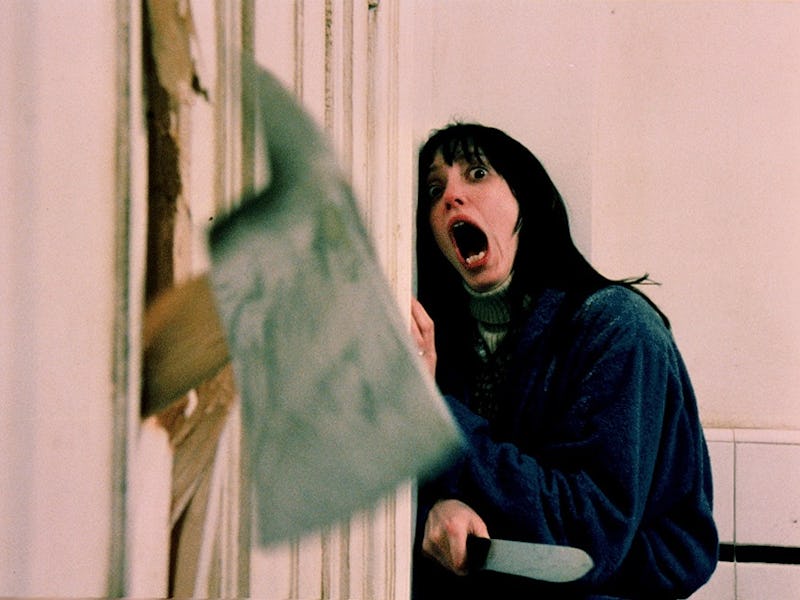Fan Theory 101: Did Kubrick Admit To Faking The Moon Landing In 'The Shining'?
'The Shining' is a mere apology vessel.

The examination of popular culture is no longer a pursuit reserved for academics. Fan theories spring up across the internet every week. Anyone can toss out an idea about the hidden meaning behind a recurring prop in a TV show or a seemingly insignificant character stenciled into the background of comic book panels. It doesn’t matter if there are letters after your name as long as you put forth a compelling argument that taps into an unexplored idea. Some theories thrive and others take a nosedive upon closer inspection. Let’s see which ones stand up.
Stanley Kubrick adapted Stephen King’s The Shining in 1980. He took many liberties with the original novel to the point that King’s tome transformed from a straightforward haunted house chiller into a movie ripe with symbolism and imagery. A perfect document for conspiracy theorists to rifle through in search of deeper meaning.
There are so many individual theories — some utterly batty, some a little more believable — that a dedicated documentary Room 237 delves into them all in great detail. One of which is the oft-discussed theory concerning the director’s role in the Apollo moon landings. This interpretation originates from one Jay Weidner whose individual analysis provides plenty of evidence to support Kubrick’s role as creator of the legendary faked footage.
“The real truth is that this movie is really about the deal that Stanley Kubrick made with the Manager of the Overlook Hotel (America),” Weidner writes in his blog Secrets Of The Shining. “This deal was to get Kubrick to re-create, in other words, to fake, the Apollo 11 Moon landing.”
Weidner proposes that Kubrick was approached by the U.S. government to shoot the footage in order to prove to the world that they had conquered the moon before Russia. Through his close analysis of the film he determines that the arc of writer Jack Torrance reflects Kubrick’s own dealings with the U.S. in orchestrating such an elaborate hoax. So, what’s the evidence?
In Weidner’s opinion, it’s everywhere.
Let’s start with Danny’s iconic Apollo 11 sweater. On its own it indicates that the ugly sweater trend started in the seventies. In context with the events surrounding the young lad, it points to conspiracy! Playing with his toys in the corridor a ball rolls toward him. He rises, and ventures into Room 237 — which Kubrick changed from the novel’s room 217 — where the rotting corpse of a woman lies in wait. Obviously, this has nothing to do with building tension or dressing up a boy in clothes indicative of the film’s production era. Says Weidner of this scene:
“The audience watching the film literally sees the launch of Apollo 11, right before their eyes, as Danny rises from the floor. It isn’t the real launch of Apollo 11, it is, of course, the symbolic launching of Apollo 11. In other words - it isn’t real.”
Okay…
“Danny is literally carrying a symbolic Apollo 11, on his body, via the sweater, to the Moon as he walks over to room 237. Why do I think this? Because the average distance from the Earth to the Moon is 237,000 miles.”
It’s actually an average distance of 382,500 miles, according to NASA, but what’s 145,000 miles when your theory is iron clad? And if that doesn’t given you enough to chew over: the carpet lining the halls and corridors of the Overlook Hotel is apparently patterned after NASA’s hexagonal launching pads.
Moreover, Kubrick switched the room number on behalf of the Timberline Lodge in Oregon. The hotel where the establishing shots of the Overlook were filmed has a room 217 but no room 237. Management feared that guests would no longer wish to stay in 217 if Kubrick shot such a nightmarish sequence in that room.
The remainder of his theory draws similar comparisons to other props and stylistic choices. Jack’s typewritten mantras “All work and no play makes Jack a dull boy” are another far-fetched hint; the “All” should really be read as “A11” for Apollo 11. The twin girls were another of Kubrick’s amendments to the novel which only referenced one. Why did he change it? Weidner believes it alludes to the previous Apollo missions: Gemini.
Technical aspects add further wind to Weidner’s crackpot sails. A lighting technique known as ‘front projection’ spotted in NASA’s moon landing footage is also prevalent in The Shining and the director’s earlier works. So, he must have done it, right? Well, no. No-one, not even Kubrick, could have faked the footage. Here’s filmmaker S.G. Collins to tell you why.
The more interesting theory now might be: why Kubrick faked faking the Apollo 11 moon landing. Any takers?